Fuel Injection Fuel Rail Assembly Replacement 4.8L, 5.3L, and 6.0L Engines
Removal Procedure
Important: An 8-digit identification number (1) is located on the fuel rail. Refer to this identification number when servicing or when part replacement is required.
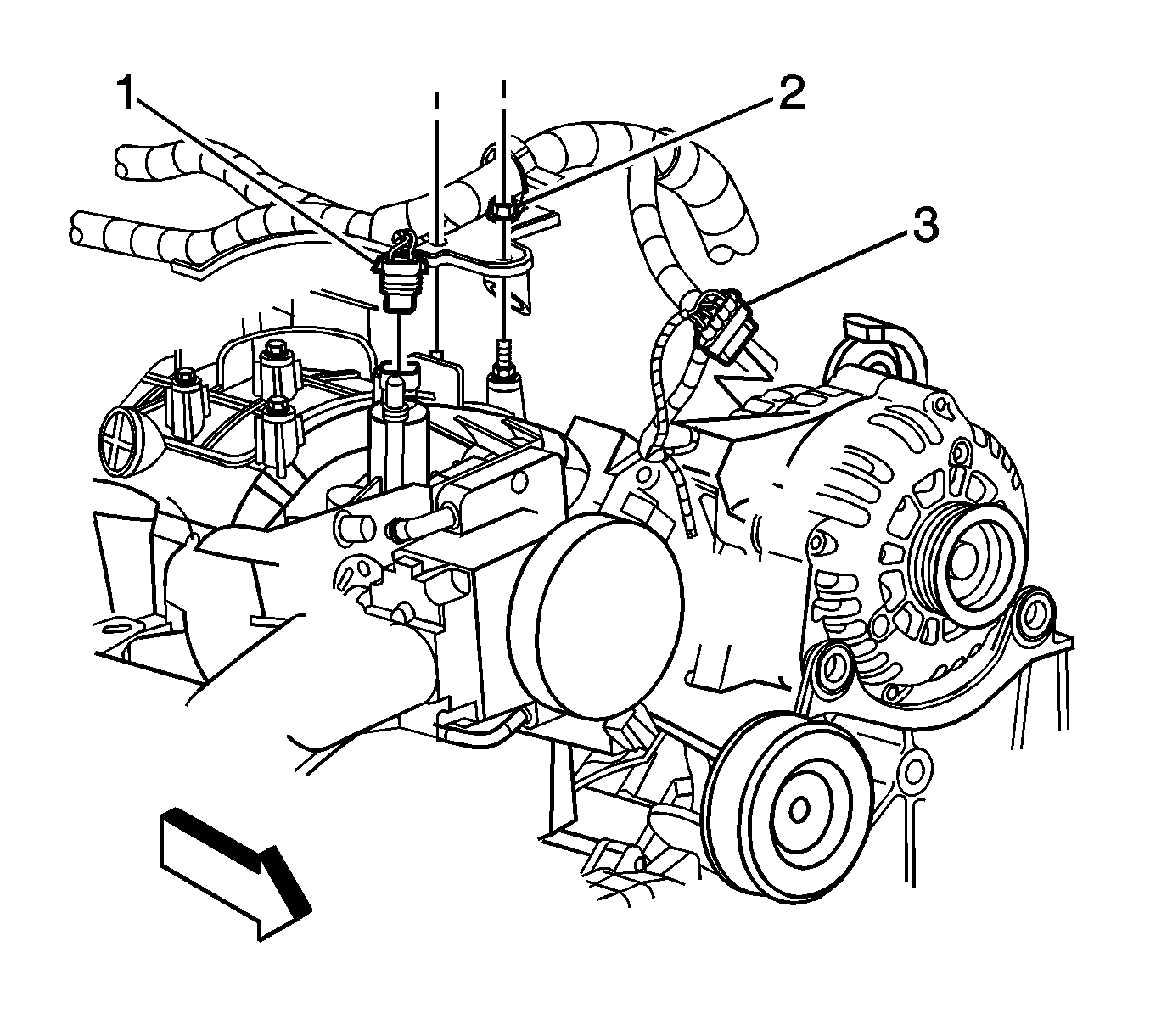
- Relieve the fuel system pressure. Refer to
Fuel Pressure Relief
.
- Remove the wire harness bracket nut (2).
- Disconnect the evaporative emission (EVAP) purge solenoid electrical connector (1).
- Disconnect the generator electrical connector (3).
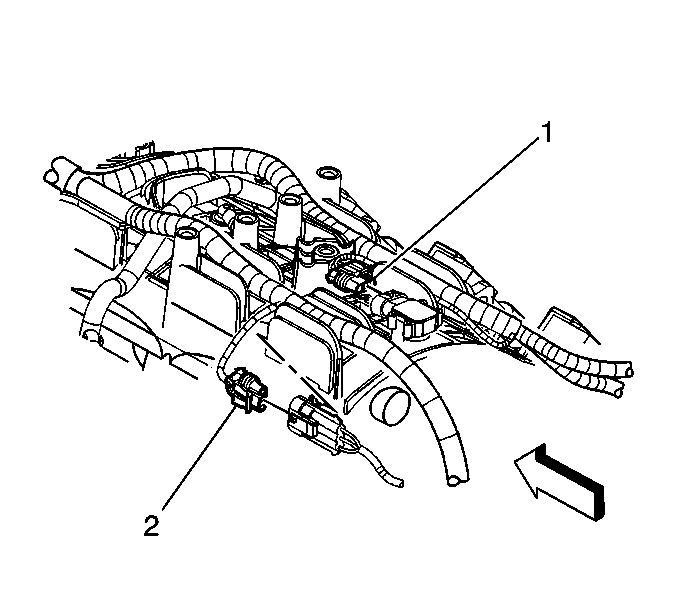
- Disconnect the following electrical connectors:
| • | Manifold absolute pressure (MAP) sensor (1) |
- Remove the knock sensor harness connector from the intake manifold.

- Disconnect the electronic throttle control (ETC) electrical connector (2), preform the following:
| 7.1. | Disengage the gray retainer. |
| 7.2. | Push down the black clip. |
| 7.3. | Disconnect the connector. |
- Remove the connector position assurance (CPA) retainer (5).
- Disconnect the following electrical connectors from the right side of the engine:
- Remove the harness clips from the fuel rail (1).

- Remove the CPA retainer from the left side of the engine.
- Disconnect the following electrical connectors from the left side of the engine:
- Remove the harness clips from the fuel rail (1).
- Reposition the engine wire harness aside.
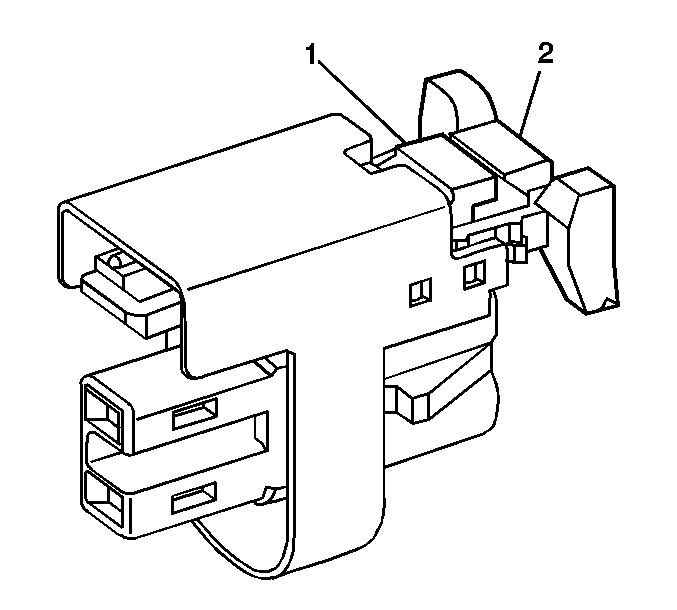
- Perform the following steps in order to disconnect the fuel injector electrical connectors.
| 15.1. | Mark the connectors to their corresponding injectors to ensure correct reassembly. |
| 15.2. | Pull the connector position assurance (CPA) retainer (2) on the connector up 1 click. |
| 15.3. | Push the tab (1) on the connector in. |
| 15.4. | Disconnect the fuel injector electrical connector. |
| 15.5. | Repeat the steps for each injector electrical connector. |
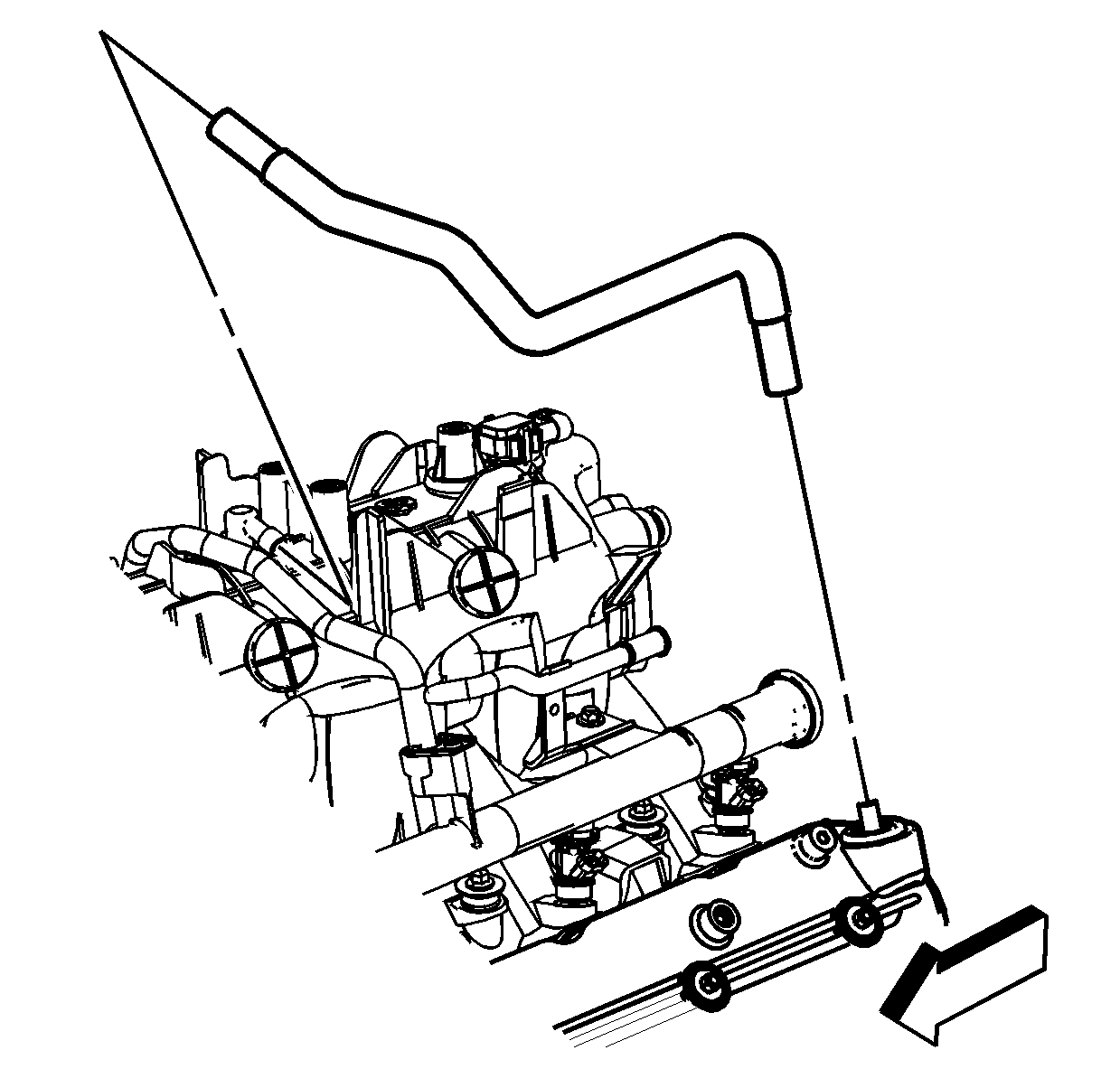
- Remove the positive crankcase ventilation (PCV) hose.
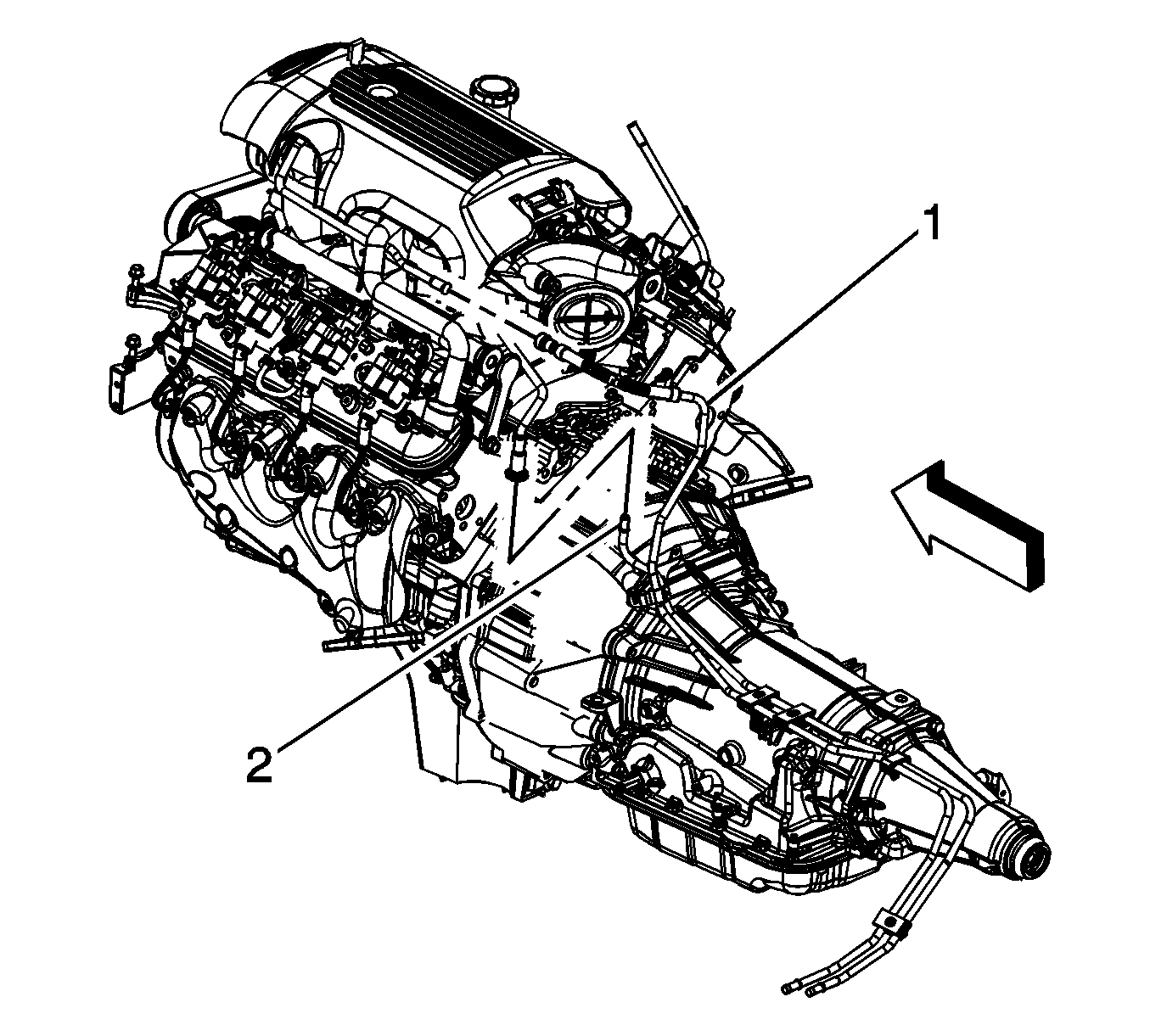
- Disconnect the fuel feed pipe (1) from the fuel rail. Refer to
Metal Collar Quick Connect Fitting Service
.

- Remove the fuel rail bolts.
Notice:
| • | Remove the fuel rail assembly carefully in order to prevent damage
to the injector electrical connector terminals and the injector spray tips.
Support the fuel rail after the fuel rail is removed in order to avoid damaging
the fuel rail components. |
| • | Cap the fittings and plug the holes when servicing the fuel system
in order to prevent dirt and other contaminants from entering open pipes and
passages. |
Important: Before removal, clean the fuel rail with a spray type engine cleaner, such as GM X-30A or equivalent, if necessary. Follow the package instructions. Do not soak the fuel rail in liquid cleaning solvent.
- Remove the fuel rail.
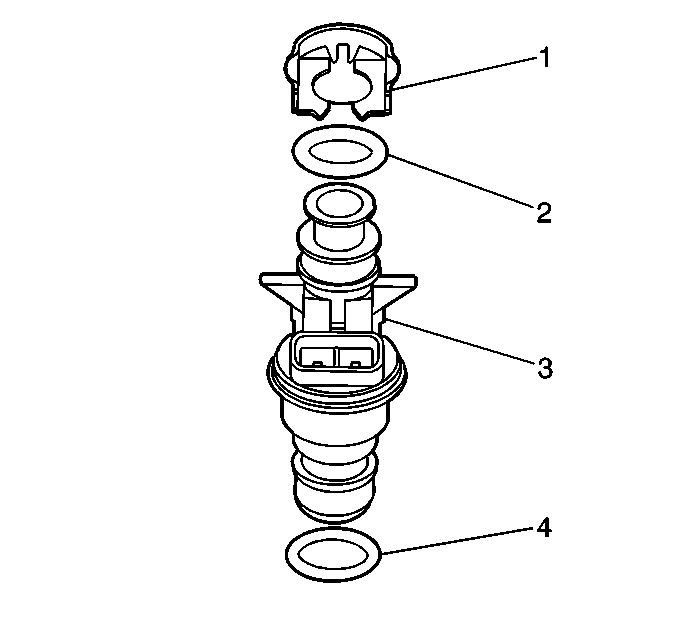
- Remove the fuel injector lower O-ring seal (4) from each injector, if necessary.
- Discard the O-ring seal.
Installation Procedure

- Lubricate NEW fuel injector lower O-ring seals (4) with clean engine oil.
- Install the NEW O-ring seals (4) onto each injector, if necessary.

- Install the fuel rail.
- Apply a 5 mm (0.2 in) band of threadlock GM P/N 12345382 (Canadian P/N 10953489), or equivalent to the threads of the fuel rail bolts.
Notice: Use the correct fastener in the correct location. Replacement fasteners
must be the correct part number for that application. Fasteners requiring
replacement or fasteners requiring the use of thread locking compound or sealant
are identified in the service procedure. Do not use paints, lubricants, or
corrosion inhibitors on fasteners or fastener joint surfaces unless specified.
These coatings affect fastener torque and joint clamping force and may damage
the fastener. Use the correct tightening sequence and specifications when
installing fasteners in order to avoid damage to parts and systems.
- Install the fuel rail bolts.
Tighten
Tighten the bolts to 10 N·m (89 lb in).

- Connect the fuel feed pipe (1) to the fuel rail. Refer to
Metal Collar Quick Connect Fitting Service
.

- Install the PCV hose.

- Perform the following steps in order to connect the fuel injector electrical connectors.
| 8.1. | Install the connectors to their corresponding injectors to ensure correct reassembly. |
| 8.2. | Connect the fuel injector electrical connector. |
| 8.3. | Push the CPA retainer (2) on the connector in 1 click. |
| 8.4. | Repeat the steps for each injector electrical connector. |

- Position the engine wire harness.
- Connect the following electrical connectors to the left side of the engine:
- Install the harness clips to the fuel rail (1).
- Install the CPA retainer.

- Connect the following electrical connectors to the right side of the engine:
- Install the CPA retainer (5).
- Install the harness clips to the fuel rail (1).
- Connect the ETC electrical connector (2), preform the following:
| 16.1. | Connect the connector. |
| 16.2. | Engage the gray retainer. |

- Connect the following electrical connectors:
- Install the knock sensor harness connector to the intake manifold.

- Connect the EVAP purge solenoid electrical connector (1).
- Connect the generator electrical connector (3).
- Install the wire harness bracket nut (2).
Tighten
Tighten the nut to 5 N·m (44 lb in).
- Tighten the fuel fill cap.
- Connect the negative battery cable. Refer to
Battery Negative Cable Disconnection and Connection
.
- Use the following procedure in order to inspect for leaks:
| 24.1. | Turn the ignition ON, with the engine OFF, for 2 seconds. |
| 24.2. | Turn the ignition OFF for 10 seconds. |
| 24.3. | Turn the ignition ON, with the engine OFF. |
| 24.4. | Inspect for fuel leaks. |
Fuel Injection Fuel Rail Assembly Replacement 5.3L (L59) Engine
Removal Procedure
Important: The L59 E85 fuel rail is comprised of a material that is compatible with fuel that has a concentration of up to 85 percent ethanol. The E85 fuel rail also uses an E85 Denso fuel injectors. Because of this, special procedures
will be used in servicing the fuel rail and associated components. The screws that fasten the retaining clips for the crossover pipe to the fuel rails are thread cutting and therefore should NOT be removed from the fuel rail. The fuel rail will be serviced as
an entire component.
Important: An 8-digit identification number (1) is located on the fuel rail. Refer to this model identification number if service or part replacement is required.
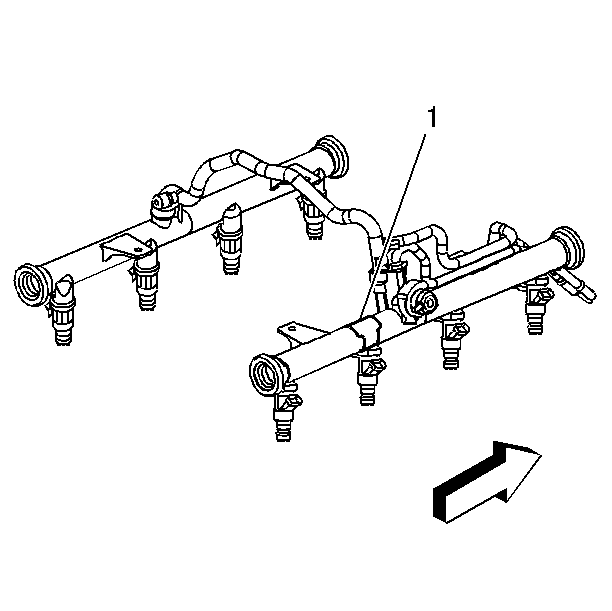
- Relieve the fuel system pressure. Refer to
Fuel Pressure Relief
.

- Remove the wire harness bracket nut (2).
- Disconnect the evaporative emission (EVAP) purge solenoid electrical connector (1).
- Disconnect the generator electrical connector (3).

- Disconnect the following electrical connectors:
| • | Manifold absolute pressure (MAP) sensor (1) |
- Remove the knock sensor harness connector from the intake manifold.

- Remove the connector position assurance (CPA) retainer.
- Disconnect the following electrical connectors from both sides of the engine:
- Remove the harness clips from the fuel rail (1).
- Reposition the upper engine wire harness aside.

- Perform the following steps in order to disconnect the fuel injector electrical connectors:
Important: When disconnecting the Multec® 2 fuel injector connectors, DO NOT use pliers or other hand tools, as the connector ends may become mangled and be rendered unusable.
| 11.1. | Mark the connectors to their corresponding injectors to ensure correct reassembly. |
| 11.2. | Pull the connector position assurance (CPA) retainer (2) on the connector up 1 click. |
| 11.3. | Push the tab (1) on the connector in. |
| 11.4. | Disconnect the fuel injector connector electrical connector. |
| 11.5. | Repeat the steps for each injector connector. |

- Remove the positive crankcase ventilation (PCV) hose.
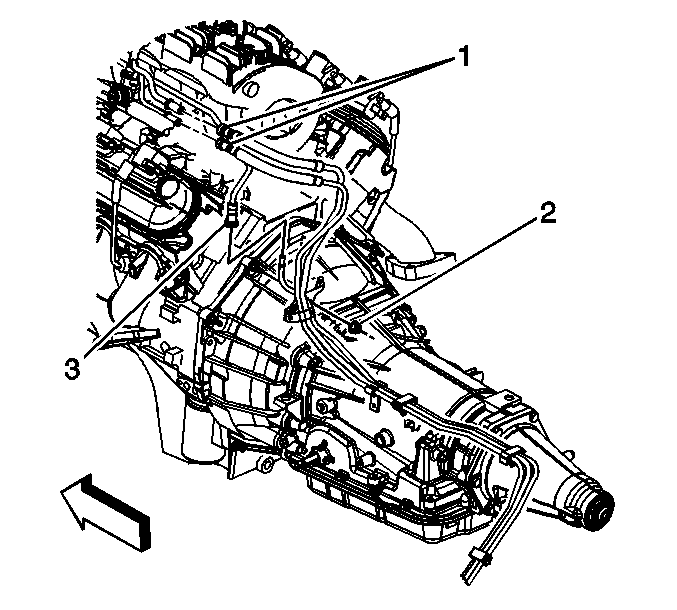
- Disconnect the fuel feed and return pipes (1, 2) from the fuel rail. Refer to
Metal Collar Quick Connect Fitting Service
.
- Disconnect the fuel pressure regulator vacuum line.

- Remove the fuel rail bolts.
Notice:
| • | Remove the fuel rail assembly carefully in order to prevent damage
to the injector electrical connector terminals and the injector spray tips.
Support the fuel rail after the fuel rail is removed in order to avoid damaging
the fuel rail components. |
| • | Cap the fittings and plug the holes when servicing the fuel system
in order to prevent dirt and other contaminants from entering open pipes and
passages. |
Important: Before removal, if necessary, clean the fuel rail assembly with a spray type engine cleaner, use GM X-30A or equivalent. Follow the package instructions. Do not soak fuel rail assembly in any liquid cleaning solvents.
- Remove the fuel rail.

- Remove the fuel injector lower O-ring seal (4) from each injector, if necessary.
- Discard the O-ring seal.
Installation Procedure

- Lubricate the NEW fuel injector lower O-ring seals (4) with clean engine
oil.
- Install the NEW O-ring seals (4) onto each injector, if necessary.

- Install the fuel rail.
- Apply a 5 mm (0.020 in) band of threadlock, GM P/N 12345382 (Canadian P/N 10953489), or equivalent, to the threads of the fuel rail bolts.
Notice: Refer to Fastener Notice in the Preface section.
- Install the fuel rail bolts.
Tighten
Tighten the bolts to 10 N·m (89 lb in).

- Connect the fuel pressure regulator vacuum line.
- Connect the fuel feed and return pipes (1, 2) to the fuel rail. Refer to
Metal Collar Quick Connect Fitting Service
.

- Install the PCV hose.

- Perform the following steps in order to connect the fuel injector electrical connectors.
| 9.1. | Install the connectors to their corresponding injectors to ensure correct reassembly. |
| 9.2. | Connect the fuel injector electrical connector. |
| 9.3. | Push the CPA retainer (2) in the connector in 1 click. |
| 9.4. | Repeat the steps for each injector electrical connector. |

- Position the engine wire harness.
- Connect the following electrical connectors to both sides of the engine:
- Install the harness clips to the fuel rail (1).
- Install the CPA retainers.

- Connect the following electrical connectors:
- Install the knock sensor harness connector to the intake manifold.

- Connect the EVAP purge solenoid electrical connector (1).
- Connect the generator electrical connector (3).
- Install the wire harness bracket nut (2).
Tighten
Tighten the nut to 5 N·m (44 lb in).
- Tighten the fuel fill cap.
- Connect the negative battery cable. Refer to
Battery Negative Cable Disconnection and Connection
.
- Use the following procedure in order to inspect for leaks:
| 21.1. | Turn the ignition ON, with the engine OFF, for 2 seconds. |
| 21.2. | Turn the ignition OFF for 10 seconds. |
| 21.3. | Turn the ignition ON, with the engine OFF. |
| 21.4. | Inspect for fuel leaks. |



































